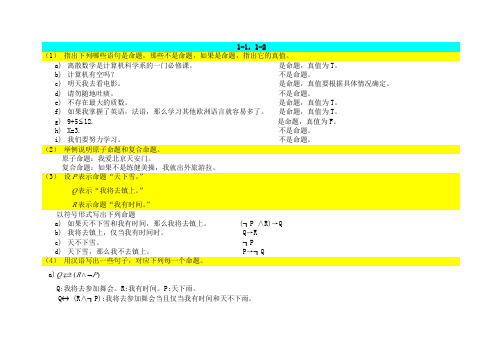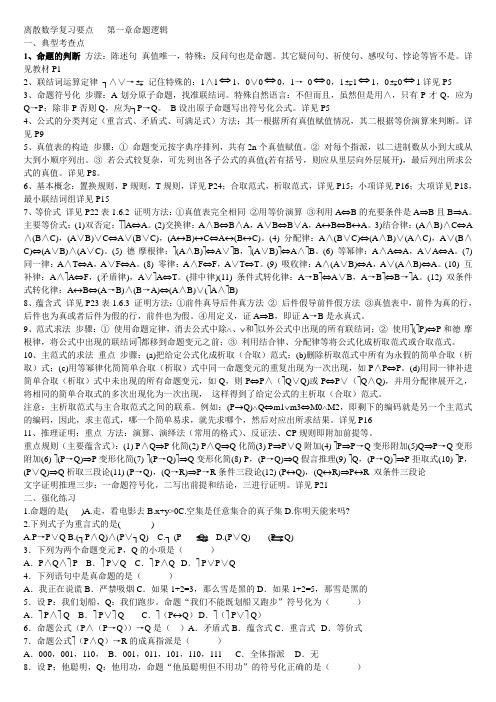离散数学第一章
- 格式:ppt
- 大小:2.70 MB
- 文档页数:209






离散数学复习要点第一章命题逻辑一、典型考查点1、命题的判断方法:陈述句真值唯一,特殊:反问句也是命题。
其它疑问句、祈使句、感叹句、悖论等皆不是。
详见教材P12、联结词运算定律┐∧∨→记住特殊的:1∧1⇔1,0∨0⇔0,1→0⇔0,11⇔1,00⇔1详见P53、命题符号化步骤:A划分原子命题,找准联结词。
特殊自然语言:不但而且,虽然但是用∧,只有P才Q,应为Q→P;除非P否则Q,应为┐P→Q。
B设出原子命题写出符号化公式。
详见P54、公式的分类判定(重言式、矛盾式、可满足式)方法:其一根据所有真值赋值情况,其二根据等价演算来判断。
详见P95、真值表的构造步骤:①命题变元按字典序排列,共有2n个真值赋值。
②对每个指派,以二进制数从小到大或从大到小顺序列出。
③若公式较复杂,可先列出各子公式的真值(若有括号,则应从里层向外层展开),最后列出所求公式的真值。
详见P8。
6、基本概念:置换规则,P规则,T规则,详见P24;合取范式,析取范式,详见P15;小项详见P16;大项详见P18,最小联结词组详见P157、等价式详见P22表1.6.2 证明方法:①真值表完全相同②用等价演算③利用A⇔B的充要条件是A⇒B且B⇒A。
主要等价式:(1)双否定:⎤⎤A⇔A。
(2)交换律:A∧B⇔B∧A,A∨B⇔B∨A,A↔B⇔B↔A。
3)结合律:(A∧B)∧C⇔A ∧(B∧C),(A∨B)∨C⇔A∨(B∨C),(A↔B)↔C⇔A↔(B↔C)。
(4) 分配律:A∧(B∨C)⇔(A∧B)∨(A∧C),A∨(B∧C)⇔(A∨B)∧(A∨C)。
(5) 德·摩根律:⎤(A∧B)⎤⇔A∨⎤B,⎤(A∨B)⎤⇔A∧⎤B。
(6) 等幂律:A∧A⇔A,A∨A⇔A。
(7) 同一律:A∧T⇔A,A∨F⇔A。
(8) 零律:A∧F⇔F,A∨T⇔T。
(9) 吸收律:A∧(A∨B)⇔A,A∨(A∧B)⇔A。
(10) 互补律:A∧⎤A⇔F,(矛盾律),A∨⎤A⇔T。
《离散数学》双语教学第一章真值表,逻辑和证明《离散数学》双语教学第一章真值表,逻辑和证明CHAPTER 1TRUTH TABLES, LOGIC, AND PROOFSGlossarystatement, proposition:命题 logical connective:命题联结词compound statement:复合命题 propositional variable:命题变元negation:否定(式)truth table:真值表conjunction:合取 disjunction:析取 propositional function:命题公式fallacy: 谬误syllogism:三段论universal quantification:全称量词化 existential quantification:存在量词化 hypothesis(premise): 假设~前提~前件 conditional statement, implication:条件式~蕴涵式 consequent, conclusion:结论~后件 converse:逆命题contrapositive:逆否命题biconditional, equivalence:双条件式~等价(逻辑)等价的 logically equivalent:contingency:可满足式tautology:永真式(重言式)contradiction, absurdity:永假(矛盾)式 logically follow:是…的逻辑结论 argument:论证axioms:公理第 1 页共 47 页 2010-12-27《离散数学》双语教学第一章真值表,逻辑和证明 postulate:公设rules of reference:推理规则modus ponens:肯定律 modus tollens:否定律reductio ad absurdum:归谬律proof by contradiction:反证法counterexample:反例 minterm:极小项disjunctive normal form:主析取范式maxterm:极大项conjunctive normal form:主合取范式第 2 页共 47 页 2010-12-27《离散数学》双语教学第一章真值表,逻辑和证明本章内容及教学要点:1.1 Statements and Connectives教学内容:statements(propositions)~compound statement~connectives:negation~conjunction~disjunction~truth tables 1.2 Conditional Statements教学内容:implications(conditional statements)~biconditional~equivalent~and quantifications1.3 Equivalent Statements教学内容:logical equivalence~converse~inverse~contrapositive~tautology~contradiction(absurdity)~contingency~properties of logical connectives1.4 Axiomatic Systems: Arguments and Proofs教学内容:rules of reference~augument~valid argument~hypotheses~premises~law of detachment(modus ponens)~syllogism~modus tollens~addition~proof by contradiction 1.5 Normal Forms教学内容:minterm~disjunctive normal form~maxterm~conjunctive normal form定理证明及例题解答第 3 页共 47 页 2010-12-27《离散数学》双语教学第一章真值表,逻辑和证明Logic, developed by Aristotle, has been used through the centuries in the development of many areas of learning including theology, philosophy, and mathematics. It is the foundation on which the whole structure of mathematics is built. Basically it is the science of reasoning, which may allow us to determine statements about mathematics whether are true or false based on a set of basic assumptions called axioms. Logic is also used in computer science to construct computer programs and to show that programs do what they are designed to do.逻辑学是研究人的思维形式的科学. 而数理逻辑是逻辑学的一个重要分支~是用数学形式化的方法研究思维规律的一门学科. 由于它使用了一套符号来简洁地表达出各种推理的逻辑关系~故它又称符号逻辑.数理逻辑用数学方法研究推理、利用符号体系研究推理过程中前提和结论之间的关系. 数理逻辑的主要内容:逻辑演算(L和L)、公理化集合论、模型论、S p构造主义与证明论. 数理逻辑在电子线路、机器证明、自动化系统、编译理论、算法设计方法方面有广泛的应用.The rules of logic specify the meaning of mathematicalstatements. Logic is the basis of all mathematical reasoning, and it has practical applications to the design of computing machines, to system specifications, to artificial intelligence(AI), to computer programming, to programming languages, and to other areas of computer science, as well as to many other fields of study.第 4 页共 47 页 2010-12-27《离散数学》双语教学第一章真值表,逻辑和证明1.1 Statements and Connectivess(命题和联结词)命题逻辑研究的对象是命题及命题之间的逻辑关系.Propositions are the basic building blocks of logic. Many mathematical statements are constructed by combining one or more propositions.定义1.1.1 A proposition is a statement or declarative sentence that is either true or false, but not both,命题是一个非真即假的陈述句,.因此不能判断真假的陈述句、疑问句、祈使句和感叹句都不是命题.,1, The true or false value assigned to a statement is called its truth value; (一个命题的真或假称为命题的真值. 真用T或1表示~假用F或0表示),2, 一个陈述句有真值与是否知道它的真假是两回事.例1.1.1 判断下列语句是不是命题,若是~给出命题的真值: (1) 陕西师大不是一座工厂.(2) 你喜欢唱歌吗,(3) 给我一块钱吧:(4) 我不是陕西师大的学生.(5) 我正在说谎.Logical connectives(命题联结词)数理逻辑的特点是并不关心具体某个命题的真假~而是将逻辑推理变成类似数学演算的形式化过程, 关心的是命题之间的关联性. 因此需要进行命题符号化.命题联结词的作用是为了将简单命题组合成复合命题.We will now introduce the logical connectives that are used to form new propositions from existing propositions. And once truth values have been assigned to simple propositions, we can progress to more complicated compound statements.A statement that contains no connectives is called a simple第 5 页共 47 页 2010-12-27《离散数学》双语教学第一章真值表,逻辑和证明statement. We will use p,q,r…to represent simple statements(简单命题就是简单陈述句~用字母p,q,r…(或带下标)表示),Sometimes, the letters p,q,r,s,…are used to denote propositional variables that can be replacedby statements(命题变元:可以用命题代替的变元).A statement that contains logical connectives(命题联结词) is called compound statements(复合命题). In general, a compound statement may have many component parts, each of which is itself a statement, represented by some propositional variable. The truth of a compound proposition is determined by the truth or falsity of the component parts.propositional constant(命题常元):T(1)或F(0)~或者表示一个确定的命题,propositional variable(命题变元):可用一个特定的命题取代。
离散数学第一章知识点总结离散数学是现代数学的一个重要分支,它在计算机科学、信息科学、物理学等领域都有着广泛的应用。
第一章通常是对离散数学的基础概念和预备知识进行介绍,为后续的学习打下坚实的基础。
以下是对离散数学第一章知识点的详细总结。
一、集合的基本概念集合是由一些确定的、不同的对象所组成的整体。
集合中的对象称为元素。
我们通常用大写字母来表示集合,用小写字母表示元素。
如果一个元素 a 属于集合 A,记作 a ∈ A;如果一个元素 b 不属于集合 A,记作 b ∉ A。
集合有两种常见的表示方法:列举法和描述法。
列举法是将集合中的元素一一列举出来,例如 A ={1, 2, 3, 4, 5}。
描述法是通过描述元素的共同特征来表示集合,例如 B ={x | x 是大于 0 小于 10 的整数}。
集合之间的关系包括子集、真子集和相等。
如果集合 A 中的所有元素都属于集合 B,那么 A 是 B 的子集,记作 A ⊆ B。
如果 A 是 B 的子集,且 B 中存在元素不属于 A,那么 A 是 B 的真子集,记作 A ⊂ B。
如果 A 和 B 包含相同的元素,那么 A 和 B 相等,记作 A = B。
二、集合的运算集合的基本运算有并集、交集和差集。
集合 A 和集合 B 的并集,记作 A ∪ B,是由属于 A 或者属于 B 的所有元素组成的集合。
集合 A 和集合 B 的交集,记作A ∩ B,是由同时属于 A 和 B 的所有元素组成的集合。
集合 A 与集合 B 的差集,记作 A B,是由属于 A 但不属于 B 的所有元素组成的集合。
此外,还有补集的概念。
如果给定一个全集 U,集合 A 的补集记作A,是由属于 U 但不属于 A 的所有元素组成的集合。
集合运算满足一些重要的定律,如交换律、结合律、分配律等。
例如,A ∪ B = B ∪ A(并集的交换律),A ∩ B =B ∩ A(交集的交换律),(A ∪ B) ∪ C = A ∪(B ∪ C)(并集的结合律),(A ∩B) ∩ C =A ∩ (B ∩ C)(交集的结合律)等。